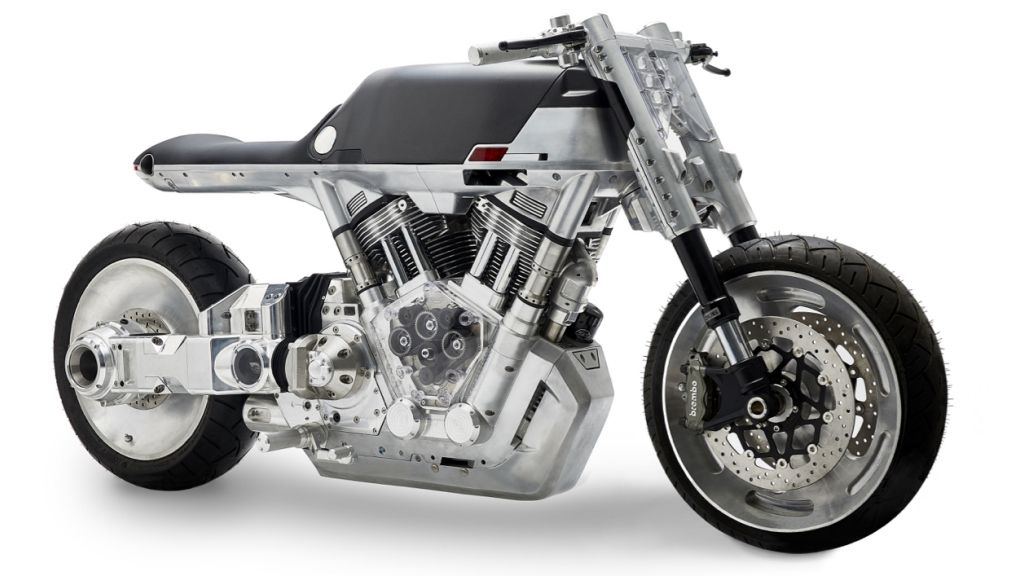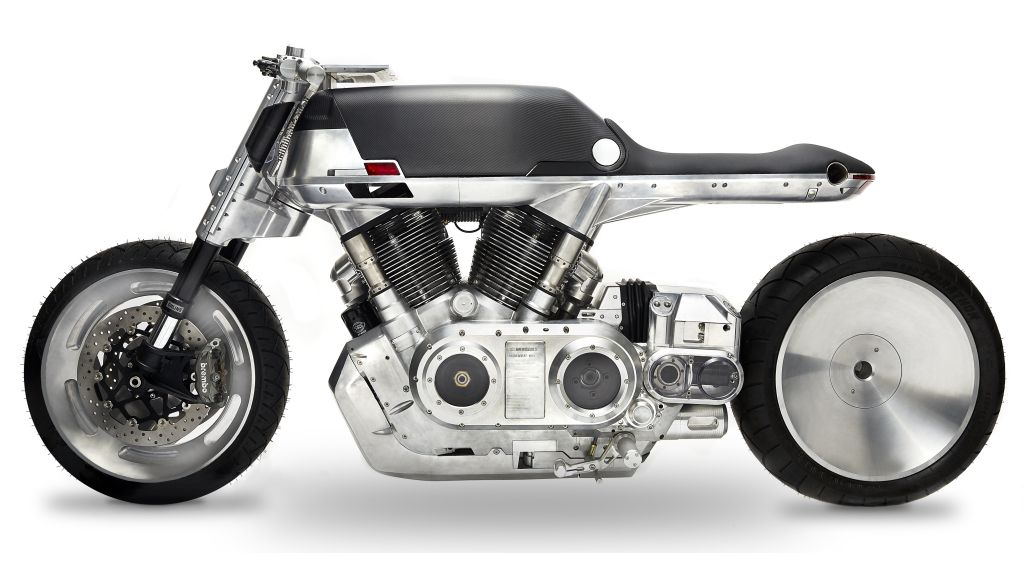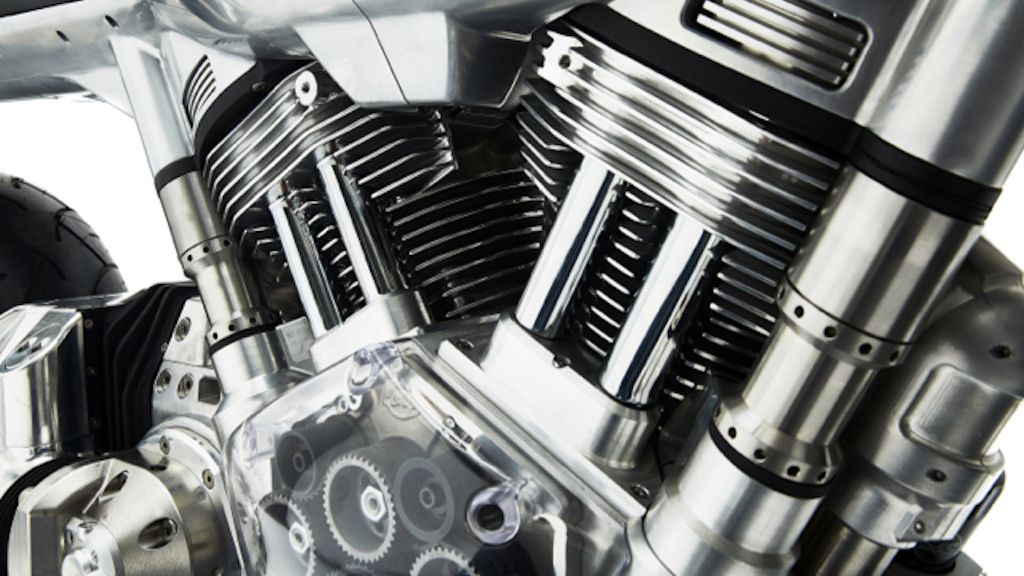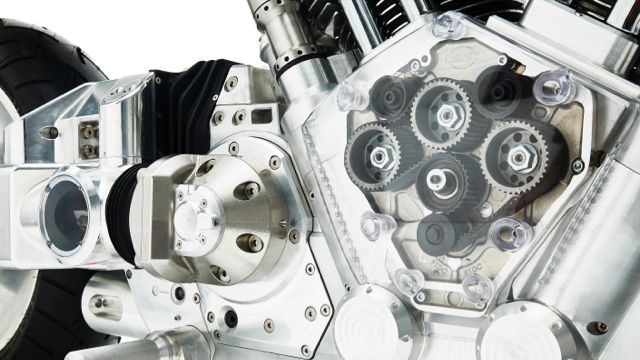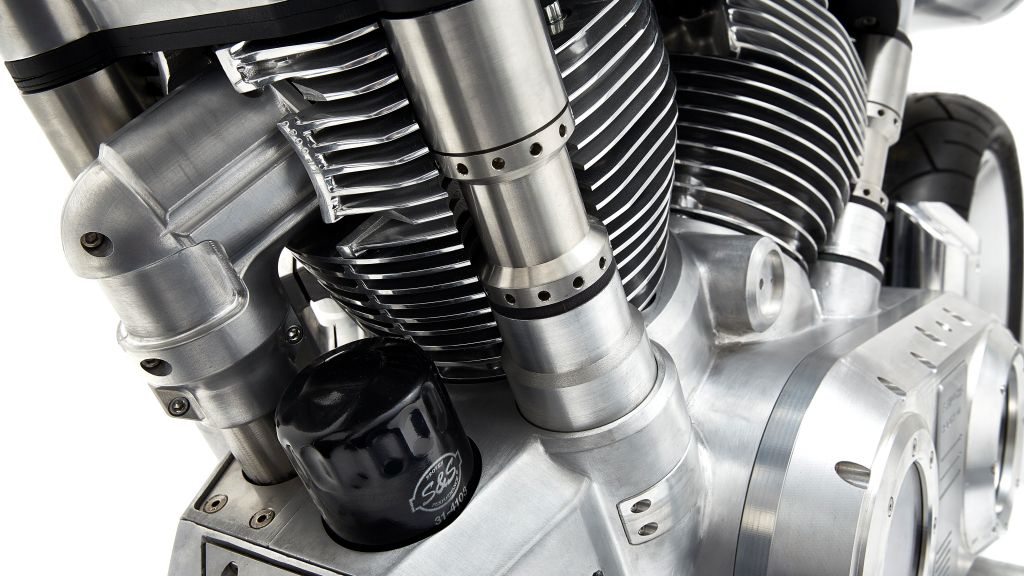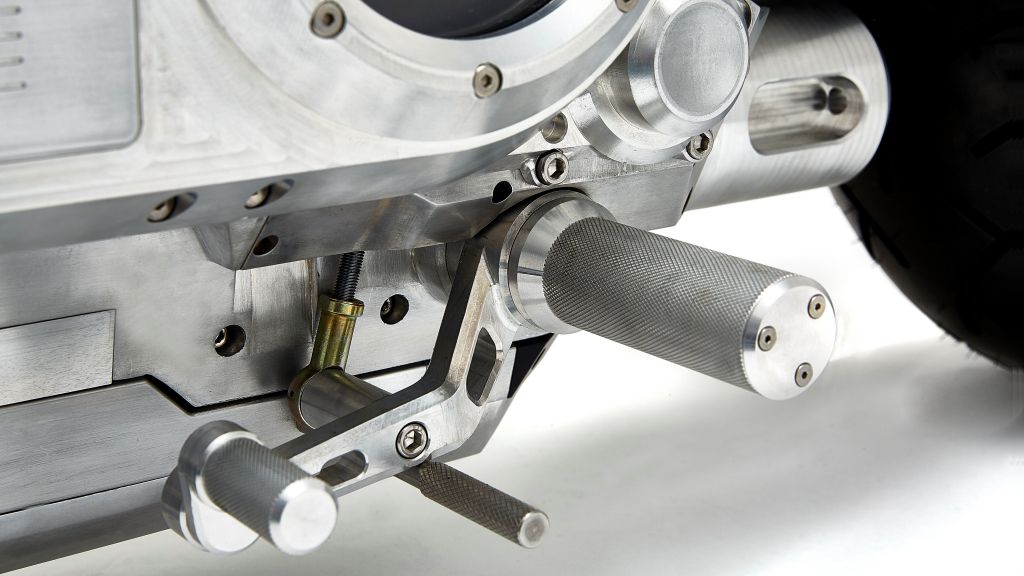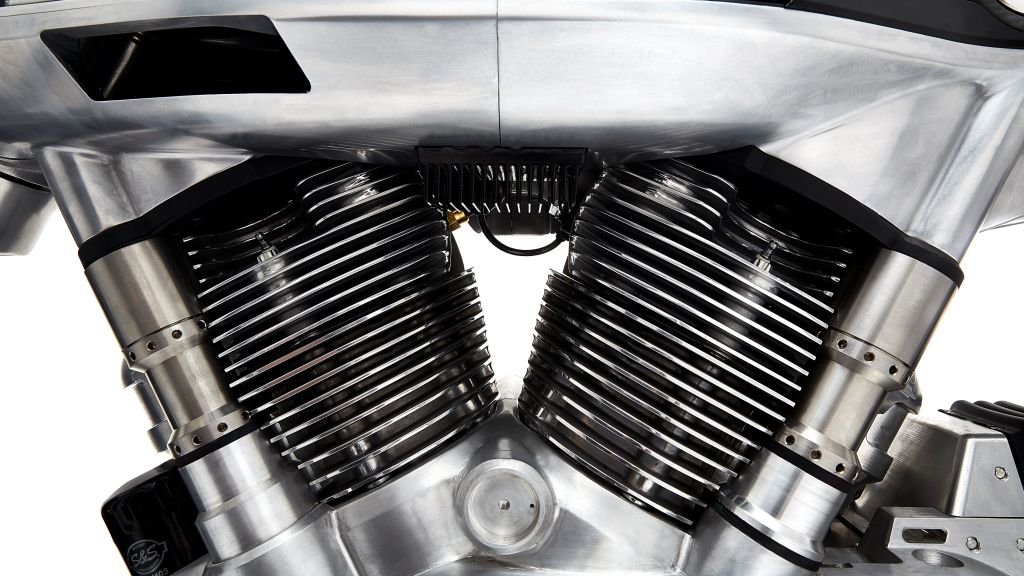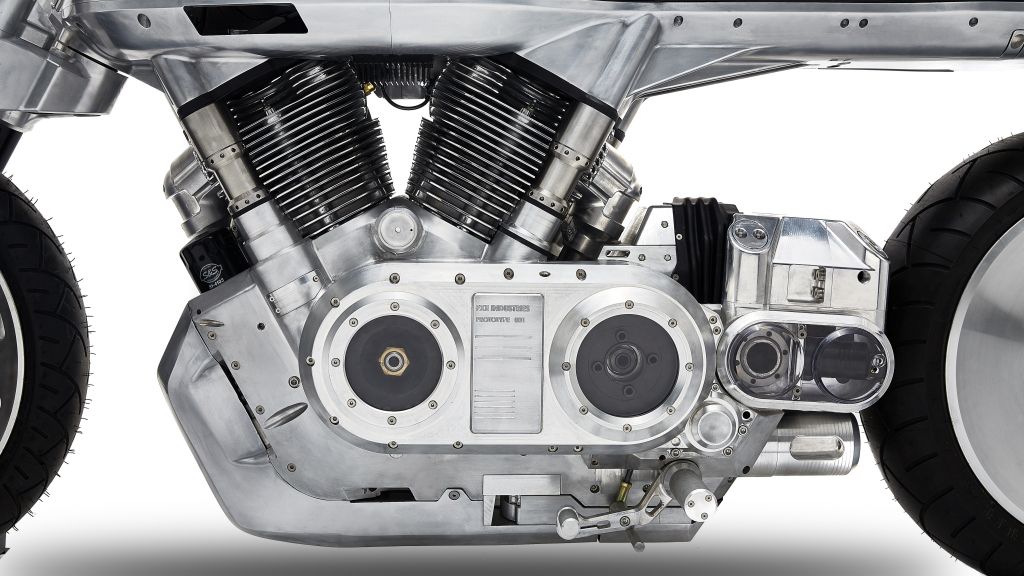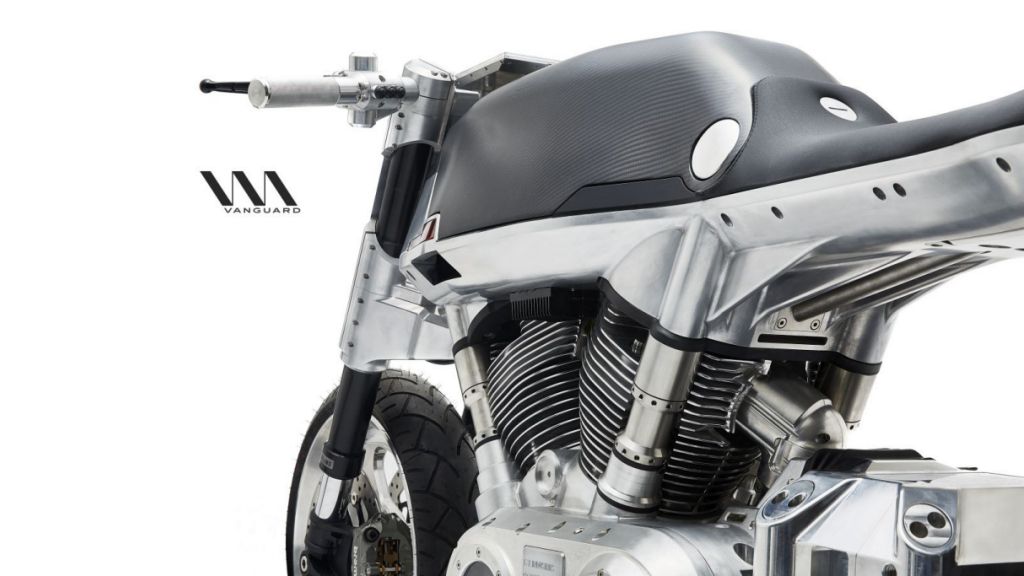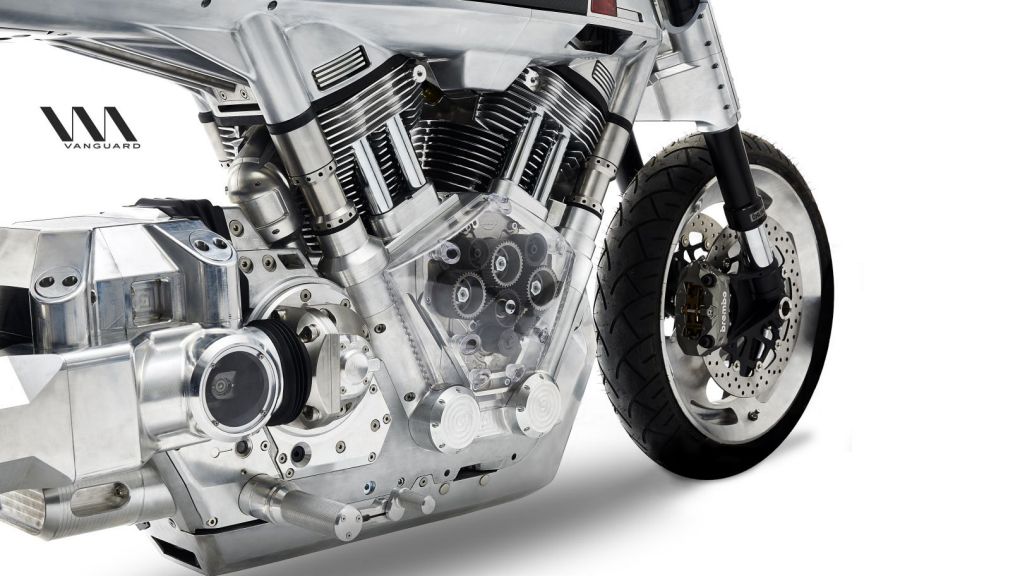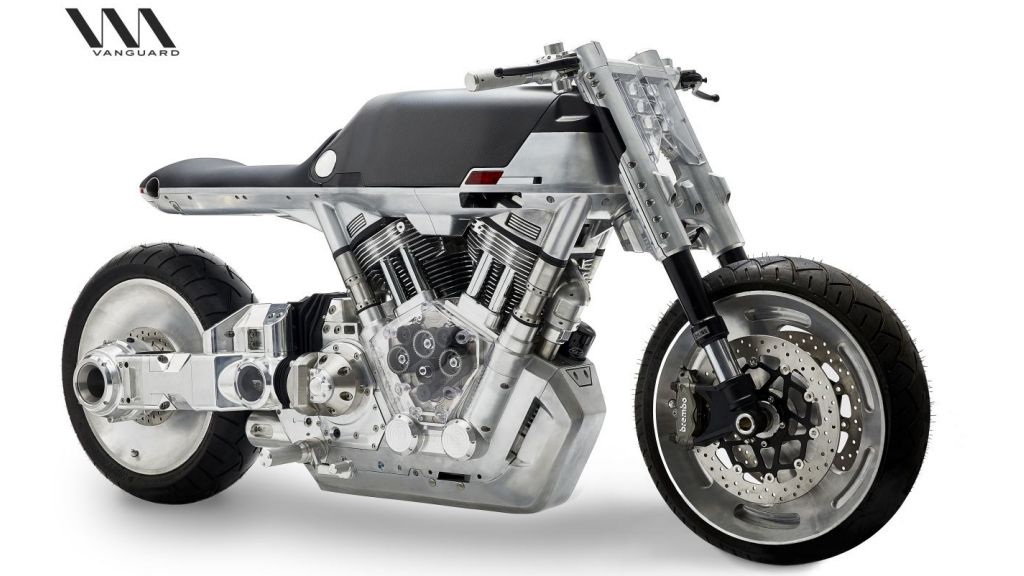Straight out of the Brooklyn Navy Yard comes the newest threat to the U.S-based, concept-bike->ke297 market; the “Roadster” by Vanguard Moto, Inc->ke5655. This is the first of three planned models, with a “Racer” and “Cruiser” just over the horizon, and what I'm seeing so far is quite impressive. Not only is this a pure-D cool looking ride, it comes with a digital pedigree that is almost unique in the full-size smoker-bike category having been largely designed in the electronic medium through CAD and 3-D printing technology.
This is a big step for would-be bike manufacturers, because it allows for relatively rapid design and production with a small team of engineers and workers, perfect for startups and builders looking to keep a small footprint. Edward Jacobs, formerly of Confederate Cycle->ke3303, is the chief engineer and designer for the company with Francois-Xavier Terny serving as CEO and supply/logistics support, and this dynamic duo has created something truly unique under the sun.
Continue reading for my look at the Vanguard Roadster.
2018 Vanguard Roadster
- Make: Array
- Model: 2018 Vanguard Roadster
- Segment: Array
- Engine/Motor: V-Twin
Design
Conventional nomenclature fails to adequately cover the various aspects of this ride, but I'm going to give it a shot 'cause you gotta' start somewhere. I suppose the “Roadster” moniker works well enough here, considering how well it fits the stripped-down, naught-but-the-essentials definition of the class. One might also recognize a certain cafe'-ness->ke3530 about the design, mainly due to the fuel tank that tapers down to knee indents ahead of the straight-and-level solo seat. Jockey-mount footpegs and clip-on handlebars place the rider in a position to lean into the wind with plenty of room to tuck in or to throw around some body English.
Spartan switch housings contain all of the hand controls with push-button switches and fluid reservoirs for the hydraulic brake and clutch contained in what looks like billet aluminum assemblies. All very clean and modern, and the seven-inch instrument screen keeps it that way by displaying all the important metrics with nary an analog gauge in sight. Not only does the display preclude the need for traditional gauges, it also serves as a monitor for the two, rear-facing cameras that eliminate the mirrors leaving the command-and-control area clean yet functional. Key? We don't need no stinkin' key! Just punch the unlock code into the display and fire it up.
The front end itself is kept spic-and-span as well, courtesy of the six-LED headlight that does away with the lamp can entirely, and the front fender that someone forgot to install. Don't get me wrong, I appreciate that the factory wanted to keep things lean, but at least throw a bobber front fender on there for the guys that get caught out in the weather, hm? The ass end is similarly sparse with a molded-in Cylon taillamp above a naked rear tire that's sure to give the rider a shower on wet roads whether it's wash-day or not. In fact, this bike is so clean it even abandons the traditional frame construction in favor of a monocoque assembly that takes the phrase “stressed engine” to a whole new level. Let's examine that facet next.
Chassis
Much like the starship Enterprise with its detachable saucer section, this bike is comprised of two distinct components that are coupled together in the middle. Seat, tank, steering head and front end make up the top half while the engine, transmission and swingarm/rear end form the bottom. Four pillars or stanchions make the connection between the stressed engine cases and the fuel tank area with the rocker-box area of the big V-twin mill tucked away within the upper assembly.
The front end carries a bit of rake at 27 degrees, but the factory is keeping trail close to the vest for the time being so speculation on handling characteristics will have to wait. Wheelbase measures out at 65.5-inches long, and while the Metzeler Marathon hoop up front measures out at 130/60 VR18, buyers can choose between a 200/50 ZR18 or massive, 240/40 VR18 in back. Cutouts add style and reduce weight at the front rim, but the rear hoop comes on an eye-catching solid wheel.
The single-sided swingarm pulls double duty as a housing for the drive shaft, and it comes mounted to the transmission case for a clean alternative to the traditional frame. A monoshock supports the rear from its hidden place behind the tranny, and fully adjustable, 48 mm, inverted front forks buoy the front. Suspension at both ends comes off the top shelf -- you know, where they keep the Öhlins stuff. (wink, nudge...).
The brakes are likewise top-of-the-line with Brembo products all the way around. A set of four-pot, opposed-piston calipers bite the dual, 320 mm front discs, and a twin-piston caliper binds a 245 mm disc in back. The rear brake necessarily comes tucked away on the swingarm side of the wheel, leaving the left side completely open and visible. Doesn't look like ABS is on offer (yet?), but I don't necessarily see that as a negative on a ride like this.
Drivetrain
The beating heart is nearly as interesting as the rest of the machine. What we have here is a mill based on the S&S X-Wedge engine. The 56-degree V-twin displaces a massive, 1,917 cc (117 cubic-inches), which is actually larger than some automotive engines at present. A clear “nosecone” leaves the cam gears and timing belt plainly visible, which is a neat touch, and unlike the old Tillotson carburetors that came with a plastic bowl, safe enough I reckon.
Even though I'm not seeing any fancy traction control system or programmable rider modes, the sheer displacement of the mill and the S&S pedigree means the 110 pound-feet “target torque” and estimated 100 horsepower probably is not too ambitious for the plant to handle, but we'll see when we start getting them on some third-party dynamometers and on the track to check the estimated 143 mph top speed.
Meanwhile, we have a large V-twin engine with lots o' curb appeal and a Harley->ke300-esque, pushrod-style valvetrain to actuate the four-valve heads. What isn't so Harley-like is the shaft drive that runs off the six-speed transmission, but that's a change I can live with considering how clean the running gear is on this ride.
Thankfully, the factory kept to tradition when it came to dealing with waste heat. It's an air-cooled engine with functional cooling fins and no need for a clunky and ugly radiator that would just wreck the looks of the front end anyway.
Price
OK, so if you're all fired up and ready to run out and buy one of these pieces of rolling/working art, I have some mixed news for you. First, if you've been looking at other small U.S. builders such as Arch and Confederate, then the $30,000 anticipated price tag on the Roadster is probably a pleasant surprise. While it isn't exactly a bargain-basement deal, the Roadster's looks would appeal to the same sort of buyer as the other two, but at a fraction of the price, so it's relatively inexpensive even at that price. The bad news, dear friends, is that it won't be available until 2018, but the factory will gladly take your pre-order now for one of these limited edition->ke3060 bikes. A modest, $2,000 chunk of “earnest money” is all it takes to place your order.
Competitor
How does one do a fair, across-the-board comparison with such a unique ride? With other unique rides of course, and I have just such a pair in the P51 “Combat Fighter” from Confederate Motorcycles and the KRGT-1 by Arch Moto. Although these rides don't look much alike, they all share a radical, outside-the-box panache that really doesn't compare with anything else in the production market. I suppose you could qualify all three as roadsters->ke294 in that they come with minimal appointments, and everything on the finished product serves a purpose with nothing added simply for vanity. Another thing they share is the lone-wolf saddle that leaves wanna-be passengers with nowhere to sit - a sure sign that you came alone and plan to leave alone. Ultra-modern is an adjective applicable across the board, and in my opinion, each has a charm all its own and will definitely draw attention wherever they go.
It's the attack of the killer V-twins over here and as large as the Roadster's engine is, it comes in at the bottom of this pool with only 1,917 cc and approximately 100 ponies and 110 pounds of grunt. Next up is the KRGT-1, Keanu Reeves' project bike with a 2,032 cc mill and 121.7 pound-feet of torque backed up by 122 horsepower. Finally, the monstrous, 56.25-degree V-twin in the P51 measures out at 2,163 cc with a ball-crushing 170 pounds of grunt and 145 horsepower. Having said that, the Roadster's power is definitely respectable and, as always, how much do you really need, anyway? The rest is just bragging rights.
We find the Vanguard's biggest win at the till with its $30,000 sticker. As un-cheap as that is, we have the KRGT-1 over twice that with a $78,000 tag and the P51 over four times that high at $125,000. So yeah, at these prices you could buy a pair of Vanguard Roadsters and still be ahead.
He Said
“Ya know, just a decade ago it would have been impossible for a small company to make such a well-built bike, and to do it so quickly from concept to production. This is an interesting little ride, but not just for what it is, but what it represents; a future of smaller bike builders duking it out, similar to the battle for U.S. dominance between numerous contenders at the turn of the 20th century. I don't expect this will be the last upstart, homegrown project, and I do expect to see more coming out at accessible prices like the Roadster.”
She Said
My wife and fellow motorcycle writer, Allyn Hinton, says, "The comparatively low price of this ultra-modern bike is very attractive and will surely bring in folks with closer to 'mean-average' incomes. I'm not a fan of the strong horizontal lines -- almost giving it a Lego feel -- but that is just a personal opinion. The fully digital instrumentation will appeal to lots of folks, but my ol' lady eyes can't read digits at-a-glance as well as I can take in the position of needles on analog gauges, but again, most folks will like the digital displays. What I do like is the rotating fuel tank. The tank lifts on a hinge -- not unlike the hood of a car -- to allow access to engine components that would ordinarily require removing the tank. Let's talk easy access to the valve train, yes? And if you have $11 grand laying around and you want to be a part of the action, you can be an investor in Vanguard."
Specifications
|
ENGINE: |
117 cubic inch (1917 cc) Air-cooled 56 degree V-twin (S&S X-Wedge based) |
|
TRANSMISSION: |
6 speed / shaft drive |
|
TARGET TORQUE: |
110 lb.-ft. (15.2 mkg) |
|
FRAME: |
Frameless Structural Engine |
|
FRONT SUSPENSION: |
Ohlins fully adjustable 48mm |
|
REAR SUSPENSION: |
Single-sided swingarm Ohlins mono-shock suspension |
|
FRONT BRAKE: |
Brembo 4-piston calipers 2 x 320 mm semi-floating discs |
|
REAR BRAKE: |
Brembo 2-piston floating caliper, 245 mm disc |
|
RAKE ANGLE: |
27 degrees |
|
SEAT HEIGHT: |
32 inches (813 mm) |
|
WHEELBASE: |
65.5 inches (1664 mm) |
|
FUEL CAPACITY: |
5.5 gallons (21 liters) |
|
TARGET WEIGHT: |
550 lbs (250 kgs) |
|
TIRES: |
Metzeler ME880 Marathon 240/40 VR18 or 200/50 ZR18 (rear) 130/60 VR18 (front) |


